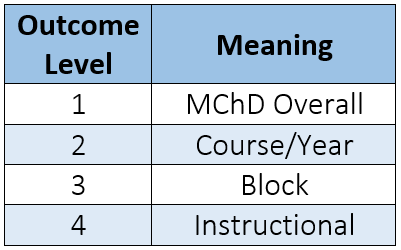Level 3 Learning Outcomes – Block 1 (Foundations)
Outcome 3.1.1: Recognise the subcellular, cellular and tissue organisation in health, discuss the function of cellular organelles and how the cell works as a whole, explain the mechanisms of cell death, and predict the implications of aging for the cell.
Outcome 3.1.2: Identify and describe the basic tissue types, be able to specify their location in the body and explain the functions of these tissues in the healthy state.
Outcome 3.1.3: Recognise the basic mechanisms underlying inflammation, wound healing and the pathophysiology of tumourogenesis and relate them to disease. Communicate these mechanisms using the appropriate terminology.
Outcome 3.1.4: Explain the cellular and non-cellular composition of blood, describe coagulation, thrombosis and haemostasis, and interpret basic haematology investigations.
Outcome 3.1.5: Recognise the components of the innate and adaptive immune response, outline the differences between the innate and adaptive immune response, describe the genetic and cellular basis of the lymphocyte repertoire, and interpret the risks and benefits of recombinant immune system.
Outcome 3.1.6: Develop an overview of the normal organisation of the human body including the musculoskeletal, visceral and nervous systems and, using appropriate terminology, describe the location of anatomical structures and their relationships
Outcome 3.1.7: Conceptualise a 3D image of the body map, list the modalities used in anatomical imaging, recognise normal anatomical features on the resulting medical images and identify significant deviations from normal.
Outcome 3.1.8: Describe the strategies used by cells to organize, regulate and integrate anabolic and catabolic pathways, explain the synthesis and utilisation of macronutrients under normal conditions and recognise where problems in metabolic pathways could lead to disease.
Outcome 3.1.9: Describe the normal physiological and chemical principles and apply this knowledge to explain the basic processes and interactions that occur at the cellular, tissue, organ and system levels in the healthy body.
Outcome 3.1.10: Describe the basic structure and function of bacterial cells and viruses, explain the mechanisms used by microorganisms to cause disease and summarise the role that microorganisms play in health as part of the commensal flora.
Outcome 3.1.11: Explain how genes function, the patterns of inheritance, why there are differences between individuals and populations and, using appropriate examples, describe how genes can influence or cause disease.
Outcome 3.1.12: Define pharmacodynamic and pharmacokinetic principles using appropriate terminology, relate these principles to the sites and mechanisms of drug action, and apply this to classify drug groups.
Outcome 3.1.13: Analyse Aboriginal and Torres Strait Islander health perspective and recognise that this represents a whole of life approach including the physical, social, emotional, spiritual, and cultural wellbeing of the person in relation to “Country”, kinships and community, and explore the way in which health services should be delivered including the “two way” interaction where traditional healers work alongside and with clinicians.
Outcome 3.1.14: Develop a study design to measure health in populations and/or quantify, interpret and explain associations between exposure and health outcomes, including the concept of causality; discuss the relevance of these measures to evidence-based medicine.
Outcome 3.1.15: Develop a basic knowledge of the core principles and historical development of law, ethics and human rights that are relevant to the practice of medicine and medical research.
Outcome 3.1.16: Articulate the fundamental philosophical ideas and principles, which underpin medical knowledge and medical practice in society.
Outcome 3.1.17: Recognise how psychological factors can impact upon a person’s physical health & well being, and appreciate how illness & medical treatments can affect a person’s psychological health and well being.
Outcome 3.1.18: Identify the role of social influence, attitudes, norms, self- concepts and identities as they affect perceptions of health and health-related behaviours.
Outcome 3.1.19: Outline the distribution of health and illness among rural Australians and recognise the context of health service delivery in rural Australia.
Outcome 3.1.20: Obtain a history from a patient so as to define the nature and course of the illness, and the biological, psychological and social context of illness; demonstrate the infection control procedures, and the process of obtaining informed consent required for physical examination; measure a patient’s vital signs; perform basic life support.
Outcome 3.1.21: Develop clinical reasoning skills and integrate information from lectures, practicals and clinical skills in Problem Based Learning cases.
Outcome 3.1.22: Recognise a problem and identify the appropriate laboratory techniques to answer scientific/clinical questions, demonstrate ability to perform and/or explain some basic laboratory techniques and analyse and interpret results from experiments or practical tasks.







